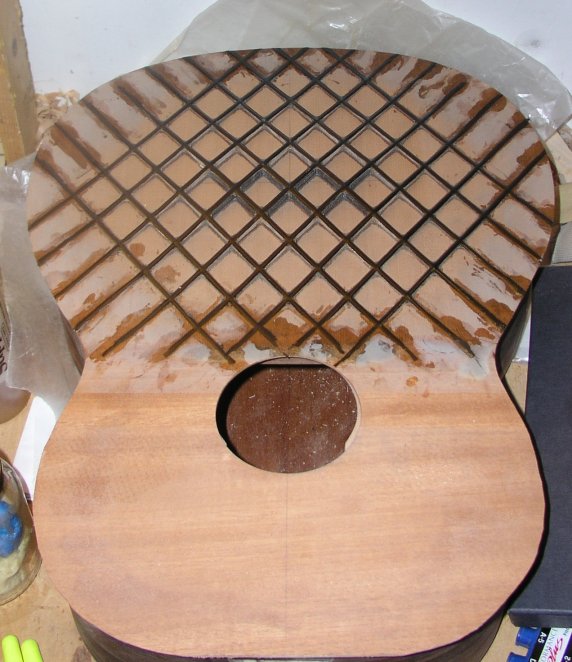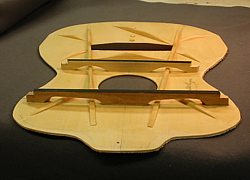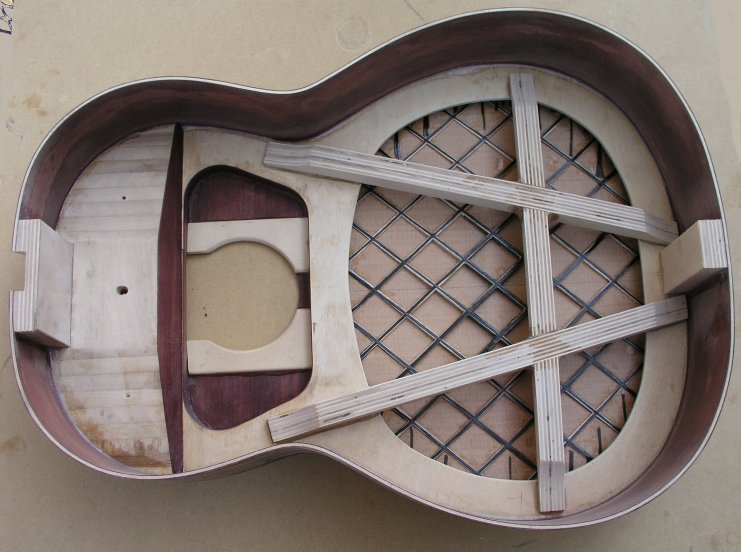
 |
|
#1
|
|||
|
|||
|
I asked the builder of a couple of my guitars about this and I may have asked a similar question a while back and I saw that that one famous Japanese builder did cross-drill some braces...and I saw some recent custom shop forum posts where a builder or two use laminated braces but...
Why do luthiers and companies not use engineered braces. Kind of like engineered roof trusses in home construction. They could be shaped like an I-beam and could even have the webs of the I-beams (wood of course) cross-drilled to lighten them up a little without sacrificing any strength...or they could make them out of very lightweight metal like titanium or ali (might be heavier than wood? No I think I KNOW it's heavier than wood but you could make the braces much smaller)? Or lightweight wood layers with a strip of carbon fiber reinforcement sandwiched between them? Like I said...I know that Japanese guy has cross-drilled braces before..whats his name? Yairi?? ...but engineering and tekmology has come a very long way since guitars were first braced to handle steel strings but the bracing material and construction hasn't changed much...in fact, if anything..it has gone backwards...current manufacturers mostly brag about using pre-war and forward shifted X bracing. So?? Why no engineered braces? God my memory is crap this morning...there was that builder from Canada's East Coast who had some "revolutionary" new bracing system. I "think" he got bought-out by gibson?? Other than him and that Japanese guy though it seems like (oh and I think I saw one current builder using laminated braces) no one is playing with "engineered braces". Why not? When I asked Ed (the guy who built my last two acoustics) about engineered braces he pretty much skirted the question iirc and didnt really give me an answer...hey, he's busy building guitars instead of answering every one of my stupid questions. Have you ever seen ladder bars on an old hotrod car? not the solid traction bars but the longer ones that look kind of like the triangle shaped supports like on lighting trusses if the trusses were flat..if that makes ANY sense..well, why not make braces that shape? At LEAST, you'd think they'd cross-drill solid wood braces like they started doing on Ford pick-up frames back in the day? When you remove material from the web of an I-beam you take a lot of weight away but you leave almost all the strength. Of course you wouldnt be able to scallop engineered or cross-drilled braces but maybe you wouldnt have to...or..if you put a CF reinforcement strip in the braces you could still carve the braces (scallop, taper, round/parabolic) but remove a lot more material than if they were just solid spruce or whatever other wood. And the bridgeplate...it could be made a LOT smaller (lighter?) if it was made of metal..and it would last longer...it wouldnt get all chewed-up by the ball ends of the strings and would never split along the grain. So everyone and especially you luthiers...why are acoustic guitars still built using 1930s bracing techniques and materials? This is the '80s for crying out loud. We have rocket appliances nowadays and space shuttles and stuff. Surely we have come up with some science and materials since 1938 that might make for better, lighter, and even stronger braces??
__________________
GONE!! 2006 Stonebridge G24SR Sitka/EIR Cutaway JJB SBT 2012 Halcyon AJ Adi/EIR 25" scale Fishman Infinity 2012 Halcyon OOO Lutz/Quilted SA Hog 12fret 25"scale JJB SBT 2019 Halcyon SJ Cutaway Lutz/Flame walnut JJB SBT Several PRS electric guitars and good old tube amps. |
|
#2
|
||||
|
||||
|
???
Tradition. And the "old way" works just fine. There's a good market for traditionally built instruments. Bel isi, -kyle
__________________
My neglected music blog: www.kylescobie.com Be sure to check out my brother's music: www.kurtscobie.com |
|
#3
|
|||
|
|||
|
Mcpherson seems to be using some engineering in their bracing design. Here is a link:
http://mcphersonguitars.com/technology/
__________________
1990 Alvarez Yairi DY-77 2009 Taylor 414ce ltd. Taz. Black |
|
#4
|
|||
|
|||
|
One of the reasons possibly would be the additional time to construct the bracing or drilling the holes. I am not sure that the sound advantages if there are any would be worth the extra time involved unless someone is willing to pay for it. Not saying they don't sound better but it creates a lot of extra work.
|
|
#5
|
||||
|
||||
|
Hmm...
    
__________________
Derek Coombs Youtube -> Website -> Music -> Tabs Guitars by Mark Blanchard, Albert&Mueller, Paul Woolson, Collings, Composite Acoustics, and Derek Coombs "Reality is that which when you stop believing in it, doesn't go away." Woods hands pick by eye and ear
Made to one with pride and love To be that we hold so dear A voice from heavens above |
|
#6
|
|||
|
|||
|
If memory serves the Larson Bros. used laminated braces.
OTOH while the braces stiffen and strengthen the top, they also control the tone and responsiveness - they also seem to need some flexibility. Or not. Complicated physics to be sure.
__________________
Chris Larrivee's '07 L-09 (40th Commemorative); '09 00-03 S.E; '08 P-09 Eastman '07 AC 650-12 Jumbo (NAMM) Martin '11 D Mahogany (FSC) Golden Era type Voyage-Air '10 VAOM-06 -the nylon string- Goya (Levin) '58 G-30 Yamaha '72 G-170A (Japanese solid top) Garcia '67 Model 3 -dulcimer- '11 McSpadden |
|
#7
|
|||
|
|||
|
The engineering you mention is generally used on metal beams, which has no internal porosity. You introduce porous cellular structures by applying tensegrity principles, which gives steel or aluminium some of the elasticity, lightness and strength that organic structures possess.
Wood has this structure built in already. It's a porous fiber structure. Builders do shape it further, but the question is what kinds of optimizations are productive in the context of the guitar. |
|
#8
|
||||
|
||||
|
This is exactly right, and the reason that 95% of acoustic guitars are derived from almost 100 year old designs. There are certainly other materials to experiment with, different structural options, etc etc, but most folks want the look and sound of a good ol' wooden acoustic guitar
__________________
________________________ Acoustic Music Works Guitars, Banjos, Mandolins & Good Company A top dealer for Collings, Huss & Dalton, Kevin Kopp, Baleno Instruments, Eastman, Pisgah Banjos, OME and ODE Banjos, Northfield Mandolins, and more! (412) 422-0710 www.acousticmusicworks.com Friend us on Facebook! Follow us on Twitter! Check out our YouTube channel! |
|
#9
|
|||
|
|||
|
Garrison was building guitars with some kind of polymer frame/bracing. They were located in Newfoundland and bought out by Gibson. Not sure if that format is still being used. Never seen one,never played one. Most guitars are braced with spruce, one of the highest stiffness to weight ratios of suitable woods. The braces on a top are a relatively smaller proportion of the total overall weight. To go through the bother of ventilating the braces represents a small weight reduction and introduces stress risers that may lead to early failure.
The use of CF sandwiched between spruce has been used by small builders for quite a while. The strenght to weight ratio is not the winner with these but rather long time distortion. Compared to straight wood the CF lams have a much better recovery memory in regard to deformation. For those interested the Gore/Gilet books present a technique of doing braces that uses the I beam principle. CA between the brace and top and another on the other edge of the brace. The bracing pattern is also new and is called Falcate Bracing. Excellent books by the way. Tom
__________________
A person who has never made a mistake has never made anything |
|
#10
|
|||
|
|||
|
Braces serve several functions:
1) structural - to resist the 175 lbs (aprx) of tension on a steel string, and about 1/2 that on a classical. 2) conduct sound - any solid conducts sound more than a gas. So, the bracing pattern of a guitar is also designed to transmit sound vibrational energy to the various areas of the guitar top. This is often overlooked. The overall mass of the braces of a steel string guitar may be (guess-timation) one third or so the total mass of the top. I've never done the calculation, however, so if someone cares to calculate, I'd love to hear the answer and see how close (or far) my guesstimation is from reality. 3) Control stiffness & elasticity - Similar to an electronic speaker, a guitar top must be able to physical depress, return to 0 position, pass it, and return to 0, pass it, etc etc etc. Bracing allows the builder to control areas of stiffness and elasticity in order to shape the sound. 4) Mass - Some builders concern themselves with total mass of certain guitar parts (bridges being a good example). It is the belief of some that with too little mass in a bridge, there is less momentum to the vibrating top, and hence aim to have a consistent mass in their bridges in the effort to keep momentum in the vibrating top to improve sustain (see #3). So, engineering braces by lamination, cutting holes, etc etc simply adds extra variables to the already esoteric practice of balancing the component parts of a soundboard. I am not convinced that cutting holes in braces would offer any advantage. However, I have considered using ebony or another very dense wood for a few braces (or laminated braces) to attempt to increase sound energy conductivity from the bridge area to other areas of the sound board. Engineering braces also can add a "wow" factor and a distinguishing element to a builder's instruments, and if marketed well, can be used to convince buyers that the instrument is more valuable than a conventionally braced instrument. Myself, I rarely concern myself with gimmicks or unconventional practices when assessing a guitar's quality. I look at it, I play it. Here are the factors I use to determine quality: 1) Craftsmanship - Have the joints been made precisely and accurately? 2) Structure - Does the guitar hold up against the forces and pressures of the string tension? (I have seen several multi thousand dollar guitars that have not passed this criteria well, with evidence of top cracks or loss of geometry - ie: the guitar shape collapses - top, back, and sides). 3) Sound - How does it sound, lad, how does it sound??? 4) Playability (& setup) - How does it play, lad, how does it play?? Recently there are a lot of guitars being built in Chinese factories that in fact sound quite good and come in a lot cheaper than our traditional well known factory brands. Certain of these guitars have issues (ie: one guitar, a Washburn, that came into my shop was most certainly built with wet wood, since it had 7 cracks in its top in various location). But others seem to be built fairly well with good tone & playability. Time will tell if they survive the test of time. Sorry. You'll have to forgive me that I went on a tangent away from your original question at the end.
__________________
---- Ned Milburn NSDCC Master Artisan Dartmouth, Nova Scotia |
|
#11
|
|||
|
|||
|
Quote:
I have the utmost respect for fellow Canadians who I have met - Linda Manzer and Grit Laskin - who say about their respective innovations (wedge & Lasking arm-rest) that anyone is free to use them, just give credit to their creators.
__________________
---- Ned Milburn NSDCC Master Artisan Dartmouth, Nova Scotia |
|
#12
|
|||
|
|||
|
Ned: As I said,not sure how the Garrison faired out as an instrument.Not even sure how well they sold. If what you say is true,it would not be the first time a product was skuttled as a protective ploy. Nice to see you . Take care.
Tom
__________________
A person who has never made a mistake has never made anything |
|
#13
|
|||
|
|||
|
Basically, it's not worth the extra trouble and effort for the most part.
You engineer something like that primarily to make a more efficient structure; one that's lighter for the given stiffness and strength. A steel I-beam has a fraction of the weight of a solid member of the same stiffness, and the same is true of a wood I-beam, of course. These are used all the time in aircraft. Why not in guitars? Well, for one thing, in an airplane the spar takes most of the load in most cases, and is the heaviest part of the wing. On a guitar of traditional construction, the top plate itself is most of the weight of the top, with all of the bracing together often amounting to no more than 20-30% of the total weight. There are top designs, such as the 'lattice' shown in one of the pictures, where the top is just a membrane, often not much more than .020" thick, that's there to move air, while the lattice bracing does all the work. That's why that one lattice top has the big plywood stiffeners built in below the top itself: to take the string tension. But, on a 'standard' top, the plate itself is an important part of the structure, and also arguably has the biggest influence on the sound. Guitar sound is a pretty complicated thing. You can define the loads that an airplane wing needs to withstand, and test the structure fairly easily as you go along to see that it works. 'Good sound' is a slippery concept, and the difference between an 'average' guitar and a 'great' one can be pretty small. Often it's necessary to tweak the sound a little, and the best way to do that can be shaving the braces. That can be difficult, or even impossible, with an 'engineered' structure. Given the variability of wood, it's hard to see how you can avoid the need for this sort of thing at least once in a while. Getting back to weight: how much do you think you could drill out of a brace without weakening it? 10% maybe? So, 10% of the 30% of the top weight that's made up of bracing comes to 3% of the total. You could do better by choosing a slightly better piece of top wood, or making a lighter bridge. When they drill lightening holes in aircraft structures, they spend a fair amount of time smoothing the edges off to avoid 'stress risers'. These are the places where cracks get started. It takes a pretty sharp drill to make nice clean holes in softwood, and it's easy to chip on the exit side. Generally, in aircraft, they don't use lightening holes in parts made of solid wood, just plywood, and I suspect that's why. There is one really good reason to use engineered braces: they look really cool. I'm sure they're a great sales tool, however they work in terms of sound and structure. |
|
#14
|
|||
|
|||
|
Quote:
If the top and braces are made of the same material, how would the braces help transmit sound energy?
__________________
gits: good and plenty chops: snickers |
|
#15
|
|||
|
|||
|
Molecules and atoms bumping into one another. Physics. It is possible to get a sense of the transmission by tapping the various wooden components (including braces) before joining them. Generally, I hold the wooden piece near 1/5th its length, and tap near the 1/5th point at the other end of the piece. This allows the piece to vibrate well and gives a sense of its resonance as is. Its sound volume will give you a sense of the amount of sound energy it can conduct. Of course, there are two basic types of sound wave movements in a planar solid. One is the molecules directly bumping into one another (like the desk toy of hanging ball bearings bumping into one another). Then there is the ripple effect that is similar to the motion of a towel if you hold it by two hands and flick it like a whip to remove dust.
__________________
---- Ned Milburn NSDCC Master Artisan Dartmouth, Nova Scotia |